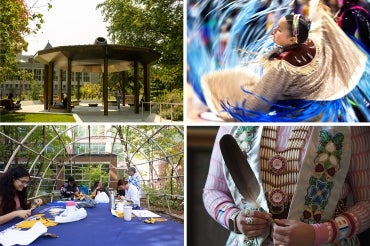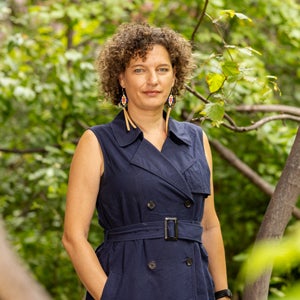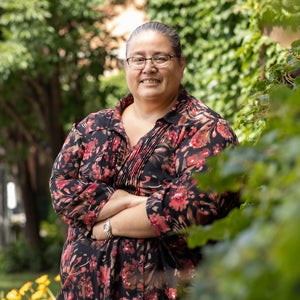Indigenous hub planned for St. George campus

(photos of Ziibiing and moccasin-making class by David Lee, All Nations Powwow dancer Brynlee Warner by Nick Iwanyshyn and Indigenous beaded stole with Eagle Feather by Polina Teif)
Published: May 1, 2025
A new Indigenous hub is planned for the University of Toronto’s St. George campus – an idea that has been a longstanding vision of Indigenous community members at the university.
The project, which now has a confirmed site near the intersection of St. George and Bloor Streets, will be a new home for Indigenous academic, administrative and student supports in a thoughtfully designed space that reflects Indigenous values.

“While we’ve made progress in recognizing Indigenous presence and contributions across the university, a dedicated space – what we often refer to as a home or a hub – has been something we’ve dreamed of for a long time,” says Shannon Simpson, senior director of the Office of Indigenous Initiatives. “It’s not just about a physical space – it will be a place of belonging, visibility and connection.”
The new hub will bring together three foundational pillars of Indigeneity at U of T’s St. George campus: the Faculty of Arts & Science’s Centre for Indigenous Studies (CIS), which fosters Indigenous scholarship through interdisciplinary research and teaching grounded in Indigenous knowledge, histories and lived experiences; First Nations House Indigenous Student Services (ISS), that has provided academic advising, cultural programming and community for Indigenous students since 1992; and the Office of Indigenous Initiatives, which leads university-wide efforts toward truth, reconciliation and decolonization and supports Indigenous students, faculty, staff and librarians while guiding institutional change through education and training, policy and relationship-building.

“This space will enable us to enhance and expand exceptional Indigenous research and teaching on campus,” says Associate Professor Susan Hill, director of CIS. “It will also foster a stronger sense of belonging for students and create space for more integrated collaboration and Indigenous knowledge-sharing across our community and beyond.”
With the site now confirmed, the university is moving ahead with the planning necessary to select a design team, which will then work closely with Indigenous partners to shape a space grounded in Indigenous values. This approach aligns with a key recommendation from Answering the Call: Wecheehetowin, U of T’s 2017 response to the Truth and Reconciliation Commission of Canada’s Calls to Action: that new Indigenous spaces be not only more visible and accessible, but also created through meaningful engagement with Indigenous communities.
Sandy Welsh, U of T’s vice provost, students, says that while the university has made significant strides toward truth and reconciliation – including the hiring of Indigenous faculty and staff across the three campuses and the creation of Ziibiing, an Indigenous landscape, in the heart of the St. George campus – more work is needed to create spaces that fully reflect and support Indigenous experiences.
“There is more to consider with this building project,” Welsh says. “Our intention is to honour our responsibilities, past, present and future, to ensure Indigenous leadership and knowledge are fully supported and visible within our institution, and also to elevate the student experience by developing more inclusive spaces.”
Simpson notes that while Wecheehetowin formalized U of T’s commitment in 2017, the call for a central, dedicated Indigenous space stretches back much further. Hence, the planned hub is not simply a response to institutional recommendations – it results from decades of advocacy by U of T’s Indigenous community.
“This space has been a long time coming,” Simpson says. “It reflects the efforts and voices of those who have pushed for change over many years, and it marks a turning point – one that not only honours the past but helps shape a future where all facets of Indigeneity are included and celebrated.”

